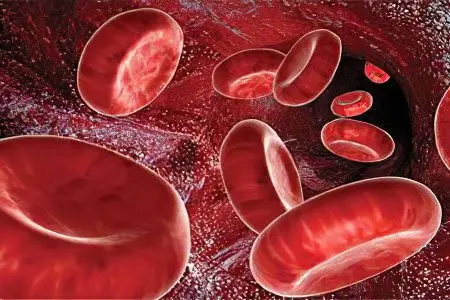Contents

Folate deficiency anemia develops when the body is deficient in folic acid, also called vitamin B9. Symptoms of this disorder are characterized by increased weakness, pallor and slight yellowness of the skin, palpitations and low blood pressure. In addition, the patient may experience disorders of the digestive system, severe weight loss and a change in the size of the spleen.
It is not difficult to detect anemia, most often a blood test is enough, although sometimes a bone marrow puncture is required. Therapy is based on the intake of folic acid in the dosages prescribed by the doctor.
Folate deficiency anemia – what is it?

Folate deficiency anemia refers to megaloblastic anemia. The reason for its development lies in the deficiency of folic acid, which a person either receives less from food, or the body is not able to absorb it, or consumes it too quickly.
This type of anemia is diagnosed less frequently than B12 deficiency anemia. Although a combination of these two anemias cannot be ruled out, sometimes iron deficiency anemia also joins them.
Folic deficiency anemia is a dangerous condition for pregnant women, as it negatively affects the development of the fetus. It also increases the likelihood of such complications of pregnancy as: placental abruption, early birth, the birth of a premature baby. Therefore, the diagnosis of this condition is carried out not only by therapists and hematologists, but also by gynecologists and obstetricians.
Causes

The body cannot synthesize folic acid on its own. He gets it from food, where it is present in the form of folate. Valuable sources of vitamin B9 are foods such as legumes, spinach, lettuce, broccoli, animal liver, meat, yeast, chocolate, etc.
In the depot of the body, there are from 5 to 10 mg of folic acid in total. Every day he spends about 50 micrograms, and during gestation, the cost of vitamin B9 is 150 micrograms per day. Therefore, if a person stops getting folate from food, then its deficiency in the body will develop in about 3-5 months. The first symptoms of anemia can be noticed when the level of folic acid drops to 4 ng / ml of blood.
The following factors can lead to the development of folate deficiency anemia:
Low intake of the substance with food.
Violation of the absorption of folic acid in the intestine.
Excessive excretion of folic acid from the body.
In the vast majority of cases, anemia is formed precisely as a result of errors in nutrition. An unbalanced menu, a deliberate restriction of oneself in food, will certainly lead to a trace element deficiency. Folic acid is destroyed during heat treatment, so prolonged cooking at high temperatures is negative.
Women who are pregnant or breastfeeding need higher doses of folic acid. Also, the needs of this vitamin increase in children born before the due date, in people with cancer. The risk group for the development of folate deficiency anemia includes patients with psoriasis, hemolytic anemia, hemoblastosis, exfoliative dermatitis.
As for the violation of the absorption of folic acid in the intestine, a similar problem is relevant for people suffering from alcoholism, for patients who have undergone resection of the stomach or intestines.
The process of absorption of vitamin B9 can be hampered by such disorders and pathologies as:
Crohn’s disease.
White diarrhea (spru).
B12 deficiency anemia.
Taking certain medications: drugs to eliminate seizures, barbiturates, hormonal contraceptives, etc.
The third factor in the development of folic acid deficiency anemia is hidden in the excessive excretion of folic acid from the body, which is observed with cirrhosis of the liver, during hemodialysis, and also against the background of heart failure.
Vitamin B9 is absorbed in the duodenum and jejunum. From them, it enters the bloodstream, where it finds plasma proteins and attaches to them. In the form of such a compound, folic acid is sent to the liver. A certain part of it remains in stocks, and the other part is excreted by the kidneys.
In the human body, vitamin B9 is in the form of tetrahydrofolic acid.
It is necessary for him to synthesize many important substances, such as:
Glutamic acid.
Pyrimidine compounds
Purine compounds.
Thymidine monophosphate, which is part of the structure of DNA.
If the body does not have enough folic acid, then blood cells are not able to divide normally. The process of normoblastic hematopoiesis is replaced by megaloblastic hematopoiesis. Failure in hematopoiesis against the background of anemia leads to the development of leukopenia and thrombocytopenia.
Symptoms of folate deficiency anemia

The symptoms of folate deficiency anemia are as follows:
Pale skin, which may give off yellowness.
Increased heart rate.
Reduced blood pressure.
Intermittent dizziness.
Disturbances in the work of the digestive system are weakly expressed. From time to time, stool liquefaction may occur.
The spleen slightly increases in size.
It is impossible to exclude the development of atrophic gastritis.
Possible symptoms of inflammation of the tongue.
With a severe course of the disease, anorexia develops.
Myocardial dystrophy develops with anemia, as a secondary lesion of the heart.
If the patient suffers from schizophrenia, psychosis or epilepsy, then folic acid deficiency anemia will aggravate the course of the underlying pathology.
Vitamin B9 deficiency is no less dangerous for women who are carrying a fetus. First of all, the child himself is under attack, which may develop a neural tube defect. In the future, this will lead to anencephaly, meningocele or hydrocephalus. Also, babies who receive less folic acid during fetal growth may be born with heart defects, with a “cleft palate” or “cleft lip”.
Among the dangers that threaten women with folate deficiency anemia are premature births, bleeding, miscarriages.
After delivery, young mothers are prone to depression, and their children lag behind their peers in physical and mental development. In addition, in children, the immune system functions worse, the efficiency of the intestine suffers.
Diagnosis of folate deficiency anemia

Investigations that need to be done in a patient with suspected folate deficiency anemia:
General blood analysis. The lack of folic acid is indicated by: hyperchromia, macrocytosis, leukopenia, thrombocytopenia, low levels of reticulocytes.
Determination of the level of folic acid in the serum part of the blood and in erythrocytes. In serum, the normal level of folic acid should remain at around 6-20 ng / ml, and in erythrocytes in the range of 100-450 ng / l.
Puncture of the bone marrow will reveal hyperplasia of the red germ, and hematopoiesis will take place according to the megaloblastic type.
Test with histidine. Folate deficiency anemia will be indicated by an increased excretion of formiminglutamic acid in urine.
ECG. In the results of the electroencephalogram, a violation of the repolarization of the myocardium of the left ventricle will be detected.
Ultrasound of the internal organs will detect an increase in the size of the spleen.
When conducting differential diagnosis, folate deficiency anemia should be distinguished from other types of anemia, with acute erythromyelosis and myelodysplastic syndrome.
How to treat?
After the diagnosis is established, the patient is prescribed treatment. Be sure to direct efforts to eliminate the factors that led to the development of anemia.
First you need to adjust the diet of the patient. His menu includes foods that are rich in vitamin B9. In parallel, the patient should take folic acid inside. The dose of the drug is 1-5 mg per day. Therapy should continue for 1-1,5 months. Perhaps intramuscular administration of folic acid, if its deficiency is caused by malabsorption at the level of the intestine. Such patients should be registered with a hematologist and receive vitamin throughout their lives.
Prevention of folate deficiency anemia

People who are at risk for the development of folate deficiency anemia require prophylactic administration of the drug. This applies to pregnant women, patients with thalassemia and hemolytic anemia.
All pregnant women, without exception, need to take folic acid as soon as they find out about their condition. Ideally, expectant mothers should take a course of folic acid during pregnancy planning. For this purpose, the drug is prescribed at a dosage of 0,4 mg per day. Folic acid intake during breastfeeding is indicated. If you follow these recommendations, then the probability of the birth of a child with disorders in the work of the central nervous system is reduced by 3,5 times.









